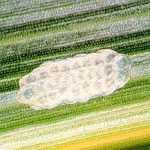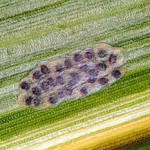Twenty-six of the 35 sites reporting this week. European corn borer (ECB)-E and ECB-Z was trapped at five sites. Corn earworm (CEW) was trapped at nineteen sites, with fifteen sites high enough to be on a 4, 5 or 6 day spray schedule (see chart below). Fall armyworm (FAW) was caught at two sites and Western bean cutworm (WBC) was caught at nine sites this week.
Below is a table showing the estimated WBC flight completion based on Hanson et al. Flight for WBC is just starting with most sites in the <1% flight completion based on degree-day accumulation.
Even though ECB trap catch numbers remain low, feeding damage has been observed in the field. If corn is in the tassel emergence stage, scout the tassel for any signs of larvae or frass (Scouting and Threshold Information). The threshold for tassel emergence stage corn is 15%.
If the corn field is silking, scout for egg masses and larvae within the ear zone. The threshold for silking corn now drops to 5% infested plants. The ear zone is the area between the two leaves above the top ear and one leaf below the bottom ear. ECB egg masses are usually located on the underside of the leaf along the midrib. The egg mass consists of 5-50 flattened eggs that overlap like fish scales (see photo below). Be sure to check the ear as well, as eggs are sometimes laid on the husk and flag leaves. Larvae are often found between the ear and stalk, or sometimes in the top of the silks. Tease the silks apart to look for feeding damage and larvae without causing too much “scouting damage”. When scouting, be sure to select scouting locations throughout the entire field to get a good estimate of infestation levels. If you would like to download a scouting form to use in the field please go to Sweet corn scouting form (pdf).
Eggs take approximately 100 base 50 degree days to hatch. Egg masses will change from white to cream to black as they age. When they appear black they are in the “black head” stage and will most likely hatch with 24 hours (see photo).
- ECB egg mass – white in color (photo University of Nebraska).
- ECB egg mass “black head” stage (photo University of Nebraska).
If the map is not visible and you are using Firefox as your browser, be sure to turn off enhanced tracking by going to the blue shield icon to the left of the URL address bar.






